ON THE EVE of his recent trip to Africa, President Obama announced sweeping new ivory bans and pledged his support for elephant conservation efforts. Presidential hopeful Hillary Clinton has repeatedly cited elephant conservation as a pressing issue of international concern and pledged $80 million through the Clinton Global Initiative to fight poaching in Africa. Elephant conservation efforts even generate bipartisan support, with lawmakers from both parties currently working to pass the Global Anti-Poaching Act.
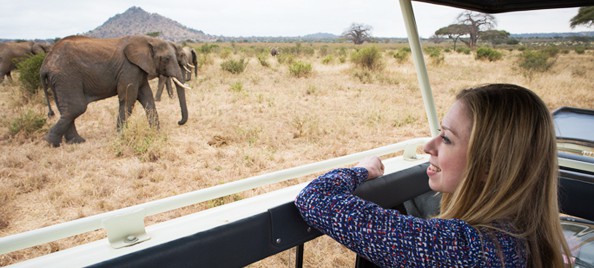
Chelsea Clinton gazes at wild elephants during an advocacy trip to Africa. Photo credit: Clinton Global Initiative.
For elephants, such support couldn’t come soon enough. Poaching pressures are at an all time high, and it is estimated that one elephant is killed every 15 minutes for its tusks. Rhinoceros, which are prized for their horns, are under extreme poaching pressures as well. Without action to deter poaching, both animals could be extinct in as little as 10 years.
Why do politicians suddenly care about poaching? Is it their love of elephants or newfound belief in sustainability? Call me cynical, but I’d say it’s doubtful.
Simply put, effective elephant conservation and anti-poaching efforts are the latest frontlines of the war on terror.
In 2013, militants connected to Al-Shabaab, Al Qaeda’s affiliate in Somalia, carried out a deadly terrorist attack at the Westgate Shopping Mall in Nairobi, Kenya, killing 67 people and wounding 175. The Lord’s Resistance Army (LRA), a guerilla group led by Joseph Kony, has kidnapped over 60,000 children for use as child soldiers since 1986. And in 2014 the Nigerian based terror group Boko Haram abducted 276 young girls for seeking an education.
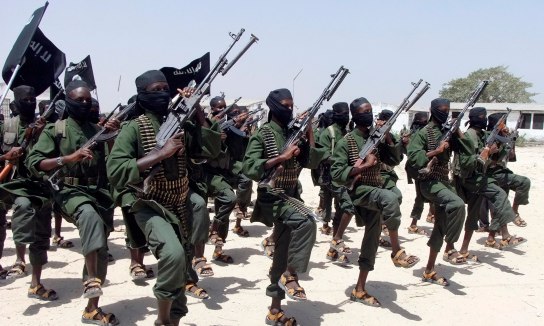
The terror group Al Shabaab may generate up to 40% of their income from poaching, totaling US$600,000 per month. Photo credit: The Guardian.
These organizations have a common source of funding. For underground terrorist organizations, the illegal trade in wildlife is a literal goldmine. Elephant ivory is a particularly prized resource at over $1000/lb on the black market. A recent report by the Elephant Action League found that illegal ivory sales earn Al Shabaab up to US$600,000 a month, a staggeringly high total that constitutes 40% of the terror group’s income.
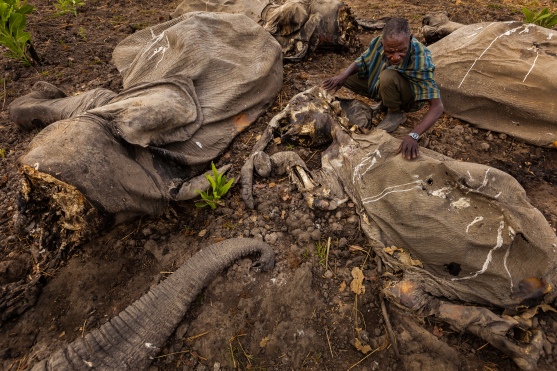
The aftermath of poaching; rangers are increasingly finding entire herds of slaughtered elephants. Photo credit: National Geographic.
Elephants haven’t always been in such dire straights. After poaching caused a population nosedive in the 1980’s, the international community moved to ban ivory in 1989. With the trade of ivory restricted across international borders, the demand for tusks dropped, poaching pressures lifted, and elephant populations stabilized throughout the 1990’s and early 2000’s.
However, several key policy flaws and legal loopholes led to the revival of African poaching.
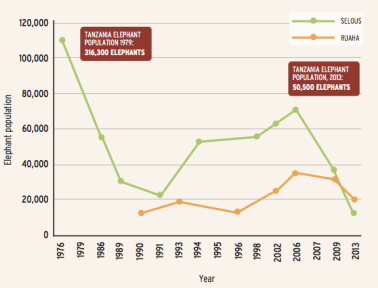
African elephant populations declined steeply during the poaching crisis of the 1980s in Selous and Ruaha national parks in Tanzania. Poaching rates are up again, and elephants are suffering. Source: Environmental Investigation Agency.
The nature of the ivory ban, which forbade the trade of ivory harvested after 1989, kept “pre-ban” ivory legal, leaving the onus on authorities to prove that seized ivory was obtained after 1989. Economic growth in China led to a rising middle class in the 2000’s that could afford expensive ivory from Africa. And in 1997 and 2004, government ivory stockpiles were auctioned off rather than being destroyed. This flooded the market, reignited ivory demand, and further muddled the legal “pre-ban” designation.

A graph of poaching rates over the last 10 years shows the percentage of all African elephants killed by illegal poaching. The dotted red line represents the annual growth rate of healthy elephant populations. When the death rate exceeds the growth rate, population size decreases. Poaching only accounts for a fraction of all elephant deaths. Source: Proceedings of the Natural Academy of Sciences.
The number of elephants killed for their tusks doubled from 2007 to 2012 as poaching underwent a resurgence. Terrorist organizations in hotbeds of poverty and political instability took notice and joined in the trade, overwhelming anti-poaching efforts that were already spread thin.
The illegal wildlife trade is the fourth largest black market worldwide after drugs, weapons and human trafficking. Valued at $19 billion annually, the trade in animal and plant parts brings in more cash than mega companies such as Facebook ($12 billion), Starbucks ($16 billion), or Ebay ($18 billion). The black market expands beyond ivory to include the exotic pet trade, illegal timber, furs, skins, and a variety of exotic animal parts such as rhino horn and tiger bones.
China is the leading market worldwide for African ivory and a driver of poaching demand. However, the United States is the second largest market for ivory, spurned by legal loopholes, insufficient funding for wildlife inspection officers, and short prison sentences for convicted offenders. It is estimated that 30% of all ivory seizures between 1994 and 2005 were made in the United States, implicating Americans as a direct source of demand for ivory.
While there are many small time ivory dealers internationally, the growing number of large ivory seizures by authorities points to the growing involvement of large, organized syndicates and cartels.
UN Secretary General Ban Ki Moon recently asserted that rampant poaching “constitutes a grave menace to sustainable peace and security in central Africa.”
As a cornerstone of US national security policy since the turn of the century, the war on terror has received incredible levels of funding and attention. As terrorism and poaching have become intertwined, politicians took notice and moved to close long standing legal loopholes that have allowed the ivory trade to survive in the United States.
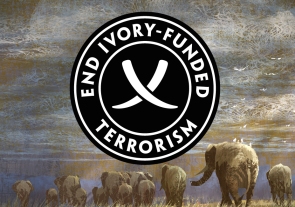
An except from the animated short “Last Days” by Kathryn Bigelow.
In 2014, President Obama revealed his new national strategy for combatting the sale of ivory. The complex web of exceptions for legal ivory was simplified, and commercial imports of ivory were banned. The burden of proof was shifted from law enforcement (who had to prove ivory was acquired illegally under the old system) to ivory dealers, who will now be required to prove that they acquired their product legally. The national strategy was coupled with efforts to increase state department funding for anti-poaching initiatives such as increased security around African national parks.
In its current form, the legislation holds the potential to eliminate the illegal ivory trade in the United States. It has yet to be approved, but enjoys strong public and political support.
Conservationists and politicians hope that the example set by the United States can persuade China and the international community to adopt similar measures, curbing the international demand for ivory and reducing poaching pressures in the process.
Tying national security to conservation concerns is an amazing strategy for conservation groups, who are often limited by funding constraints and a lack of political will. By recognizing the threat to global security posed by poaching, elephant conservation has been prioritized. When applicable, other conservation causes should try similar strategies. For example, if climate activists could successfully highlight the security concerns posed by rising sea levels and millions of climate refugees to politicians, climate change mitigation might enjoy more political support.
What YOU can do

Exotic pets constitute a large part of the illegal wildlife trade, with endangered species taking huge hits. Photo credit: National Geographic
While there is still much work to be done to stem the rise of poaching, the influx of money and political will can only help the elephant’s cause. In the meantime, do your part to make sure that you don’t inadvertently fund the illegal wildlife trade. While you should obviously never purchase ivory, there are other things you can do as well.
- Do your research before buying exotic pets such as fish, reptiles, or birds that could be endangered or illegally obtained.
- If you travel to China, Africa, or other hotspots of wildlife trade, avoid purchasing souvenirs that look like they could be sourced from illegal animal or plant materials.
- Contribute to the uplift of the community by purchasing locally crafted souvenirs made without animal products.
- Report suspicious venders to local authorities or hotel personnel.
Elephants are in trouble, but by realizing that the security needs of these majestic creatures are intertwined with our own wellbeing, we can make the world a safer place for both our species.
LEARN MORE
- Kathryn Bigelow’s short Film “Last Days” illustrates ivory-terrorism connection
- 17+ must reads on the Illegal Wildlife Trade
- US steps to Fight Poaching and Wildlife Trafficking
- World Elephant Day


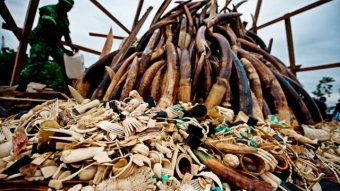

WOW, this is actually amazing. You write so eloquently and passionately, your blog is truly an inspiration to an amateur blogger!
LikeLike
Thanks so much! Always great to hear, stay tuned for future posts!
LikeLike
[…] act of cooperation and environmental conservation, the United States and China announced plans to end the commercial sale of ivory in their respective countries. China constitutes the largest ivory market in the world, with the […]
LikeLike
[…] everywhere. In Africa, demographic trends, environmental degradation, political instability, and wildlife crime have prevented the rise of large-scale, coordinated wildlife management. In the face of these […]
LikeLike
[…] of over 35,000 species worldwide, including elephants, rhinos, tigers, and sharks. Under a CITES ivory ban in 1989, African elephants rebounded as ivory demand and poaching diminished. Unfortunately, recent […]
LikeLike
[…] fossil fuels continue to push this planet down a dangerous path towards unchecked climate change. Poaching, overfishing, and invasive species threaten ecosystems around the world. Habitat loss, the number […]
LikeLike
[…] the fourth largest illicit trade globally, the illegal wildlife trade harms people and animals. Poaching and smuggling degrade ecosystems, destroy livelihoods, direct […]
LikeLike
[…] drugs, weapons and human trafficking. In addition to sea turtle eggs, wildlife products such as ivory, rhino horn, shark fins, pangolin scales, timber and exotic pets are illegally traded in global […]
LikeLike